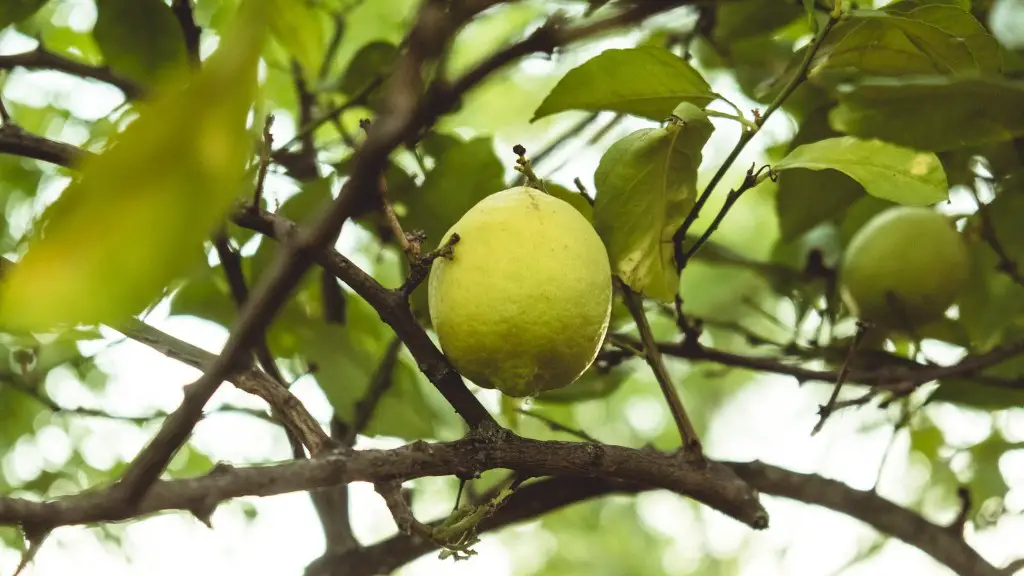An avocado tree in a pot can easily be grown indoors to supply you with a steady supply of delicious, vitamin-packed avocados. Not only is it an attractive addition to the home, it is also an incredibly rewarding gardening project. Potting an avocado tree is relatively straightforward and with a bit of dedication you’ll be harvesting your own avocados in no time.
The first step is to find the right type of avocado tree. Avocado trees come in many varieties, and larger trees will require much bigger pots than smaller ones. Dwarf varieties, such as the ‘Little Cado’ are especially popular with indoor growers and may be the best choice. ‘Little Cado’ avocado trees can reach about three feet in height and can typically be grown in a pot of about 24 inches.
Next, choose the right container and soil. Any pot with drainage holes will do, however ceramic and terra-cotta have the added benefit of reducing water evaporation, which is essential for keeping the soil moist and free-draining. Clay is a particularly good material for this purpose and is recommended by many professional growers. The soil is just as important; you need a soil that is lightweight, moisture-retentive and well-draining. A good combination of potting compost, perlite, and sand should do the trick.
The planting process is simple. Start by filling the pot with your soil mixture, then place the seedling gently into the soil. Make sure the root ball is at the correct depth, which is usually just at or below the level of the existing soil. Water the tree generously and allow to drain until the surface of the soil is moist. Regular watering is essential for a young, growing tree.
Position is also important. Avocados like a sunny spot in the home, but during hot summer months, direct sun might be too much. To prevent the soil from becoming too wet and the roots from overheating, the tree needs to be positioned in a place that receives plenty of morning sun and more filtered light as the day progresses. A south-facing windowsill is ideal for this job.
The next step is to care for your avocado tree as it grows. Water regularly so that the soil remains moist, but not soggy. If necessary, you can add a fertilizer mix to supply the tree with the nutrients it needs. Prune irregularly shaped branches or stems to encourage a fuller, tidier shape and pinch off any flowers that form in its first few years to provide energy for the tree’s growth.
Finally, remember that your avocado tree won’t produce fruit overnight. If you follow the above steps correctly, it may take several years to get a sizable crop of avocados, but patience and care will eventually be rewarded. With a little effort, you’ll be enjoying homegrown avocados for years to come.
Fertilizing Your Avocado Tree
Fertilizing is an important part of caring for your indoor avocado tree. Avocados are fast-growing and need a steady supply of nutrients to stay healthy and productive. A balanced fertilizer, such as an 8-8-8 blend, applied once a month throughout the growing season will give your tree the nourishment it needs. Fertilizers such as fish emulsion, or other organic sources can also be used but are slightly less potent.
The amount of fertilizer you use will depend on the size of the tree and the ratio given on the product’s packaging. Start with the amount given on the package and adjust as you go to find the right amount for your tree. Be careful not to apply too much fertilizer as this can harm the roots and lead to disease.
It’s also important to recognize the signs of nutrient deficiency. Yellowing leaves can indicate a lack of nitrogen, while a lack of phosphorus can lead to slow growth and smaller leaves. If you notice any of these symptoms, make sure you adjust the amount of fertilizer you use to get your avocado tree’s nutrition back on track.
Troubleshooting Common Problems
Like any other plant, avocado trees can face issues over the course of their lifetimes. Some of the most common problems include diseases, pests and nutrient deficiencies. If you suspect any of these, it is important to take the necessary steps to diagnose and correct them.
Diseases, such as root rot or stem blight, can be hard to control. In the case of root rot, check for soggy soil and rotten-looking roots. Stem blight results in dark spots on the bark and can often be treated with fungicides. As a preventative measure, make sure plants are watered and fertilized properly to minimize the risk of disease.
Pests can also be a problem. Spider mites, aphids and scale are some of the more common ones, though mealybugs and whiteflies have also been known to attack avocado trees. Introducing predatory insects, such as ladybugs and parasitic wasps, can help to keep the pest population under control. As with any pest problem, it is important to identify the infestation before taking any action.
Finally, nutrient deficiencies can cause a variety of problems, from stunted growth to yellowing leaves. If you suspect that a nutrient deficiency is the source of your tree’s problems, then a soil test can help you identify the issue and develop a plan to correct it. Nutrient deficiencies can often be corrected with a balanced fertilizer, so make sure your tree has the right amount of nutrients.
Repotting the Tree
Repotting your avocado tree is an essential part of caring for your tree as it grows. As the roots expand, it’s important to provide them with more space. Typically, avocado trees should be repotted every two to three years in a slightly bigger pot, making sure that the roots are at the same depth as before.
When repotting your avocado tree, it is important to use the same type of soil as before. Use a lightweight, free-draining soil with a high quality fertiliser and make sure there are plenty of drainage holes in the pot. It’s also important to make sure that the roots don’t become too rootbound, as this will restrict the tree’s growth. Finally, make sure that the new pot is heavy enough to keep the tree upright.
Repotting an avocado tree is an easy process and doesn’t require much effort. It is, however, a vital part of caring for the tree. Making sure you repot your tree on a regular basis will help ensure that it stays healthy and productive for many years.
Harvesting and Storing Avocados
Harvesting your own avocados is a rewarding experience, but it is important to do so at the right time. Avocados are ready to harvest when the fruit is slightly soft to the touch and yields to gentle pressure. Be careful not to pick too early as the fruit will not be at its best. If the fruit is too hard, it can be ripened off the tree by storing it in a paper bag for one or two days.
To store the harvested avocados, you have a few options. The simplest method is to store them at room temperature. This is best if you plan to use them within two or three days. If you want to keep them for longer, try storing them in a plastic bag in the refrigerator. This will slow down the ripening process and will keep them fresh for up to a week.
Alternatively, avocados can also be frozen. Simply mash the pulp, place it in an airtight container and freeze for up to six months. This is a great way to enjoy the taste of freshly-harvested avocados all year round.
Butter Avocado Uses
Avocados are not only delicious but also incredibly versatile. In addition to being eaten fresh, they can be used in many different dishes. A butter avocado, in particular, is a popular variety with a creamy texture and rich, nutty flavour.
One of the most well known uses for butter avocado is guacamole. This classic Mexican dip is usually made with mashed avocados, tomato, onion, garlic, lime juice and seasonings. Butter avocados are especially well-suited to this recipe, as their creamy texture creates a smoother, more palatable consistency. Add in some nachos and you have yourself the perfect snack.
Butter avocados are also great when added to salads. The mild nutty flavour works especially well in creamy salads, such as potato or egg salads. Alternatively, try adding them to your favourite sandwich for a touch of sweetness and smoothness. Lastly, butter avocados can also be used as a topping for tacos and burritos for a flavourful and nutritious finish.
Further Uses for Avocados
Avocados can be used in a variety of other ways too. For example, their natural oils make them a great skin and hair conditioner, and their nutritious content make them an ideal addition to smoothies and shakes. To boost the protein content of your smoothies, try adding some Greek yoghurt or tofu.
Avocados can also be used to make facial masks. Mash the avocado and mix with an egg yolk or oatmeal for a nourishing, moisturising mask. Leave on for 20 minutes and rinse off with warm water for a softer, smoother skin.
If you’re looking for a nutritious breakfast, try making avocado toast. To make, simply mash some avocado onto toast and serve with seasonings such as salt, pepper and lemon juice. Add some poached or boiled eggs for a protein hit. For a more creative twist, try adding other toppings such as smoked salmon or tomato and feta.
Finally, a butter avocado can be used to make a delicious ice cream. Simply blend the flesh with some coconut milk, honey, and your favourite spices, then freeze. The result is a creamy and nutritious ice cream that the whole family will love.



